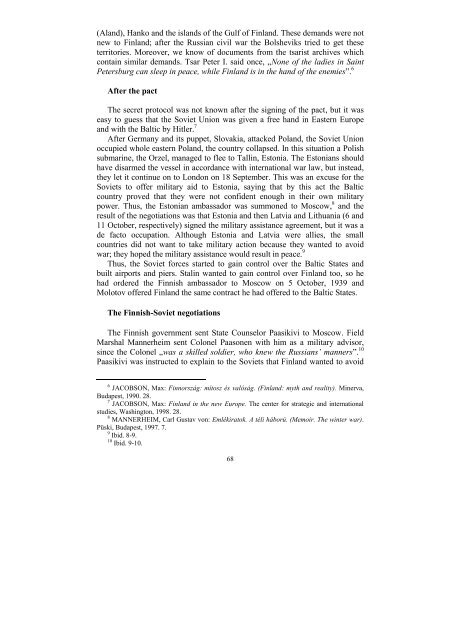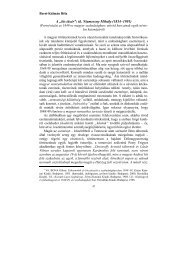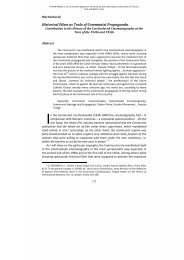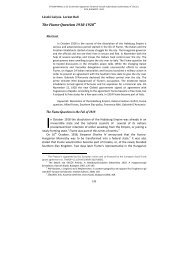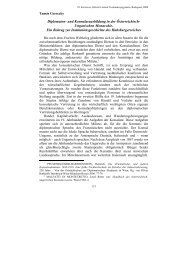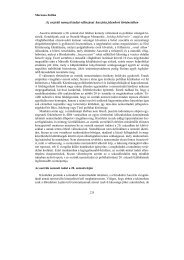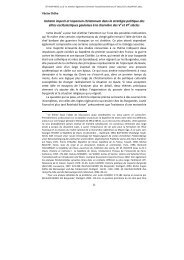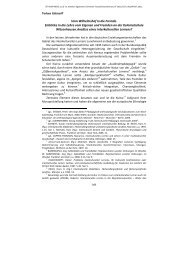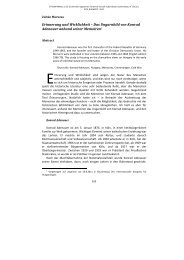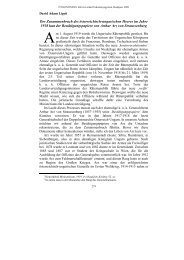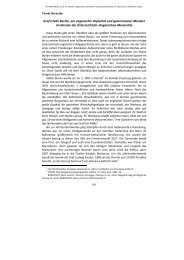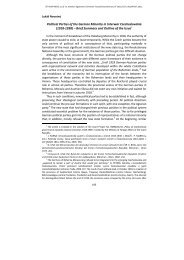The Molotov-Ribbentrop Pact - ELTE BTK Történelem Szakos Portál
The Molotov-Ribbentrop Pact - ELTE BTK Történelem Szakos Portál
The Molotov-Ribbentrop Pact - ELTE BTK Történelem Szakos Portál
Create successful ePaper yourself
Turn your PDF publications into a flip-book with our unique Google optimized e-Paper software.
(Aland), Hanko and the islands of the Gulf of Finland. <strong>The</strong>se demands were not<br />
new to Finland; after the Russian civil war the Bolsheviks tried to get these<br />
territories. Moreover, we know of documents from the tsarist archives which<br />
contain similar demands. Tsar Peter I. said once, „None of the ladies in Saint<br />
Petersburg can sleep in peace, while Finland is in the hand of the enemies”. 6<br />
After the pact<br />
<strong>The</strong> secret protocol was not known after the signing of the pact, but it was<br />
easy to guess that the Soviet Union was given a free hand in Eastern Europe<br />
and with the Baltic by Hitler. 7<br />
After Germany and its puppet, Slovakia, attacked Poland, the Soviet Union<br />
occupied whole eastern Poland, the country collapsed. In this situation a Polish<br />
submarine, the Orzel, managed to flee to Tallin, Estonia. <strong>The</strong> Estonians should<br />
have disarmed the vessel in accordance with international war law, but instead,<br />
they let it continue on to London on 18 September. This was an excuse for the<br />
Soviets to offer military aid to Estonia, saying that by this act the Baltic<br />
country proved that they were not confident enough in their own military<br />
power. Thus, the Estonian ambassador was summoned to Moscow, 8 and the<br />
result of the negotiations was that Estonia and then Latvia and Lithuania (6 and<br />
11 October, respectively) signed the military assistance agreement, but it was a<br />
de facto occupation. Although Estonia and Latvia were allies, the small<br />
countries did not want to take military action because they wanted to avoid<br />
war; they hoped the military assistance would result in peace. 9<br />
Thus, the Soviet forces started to gain control over the Baltic States and<br />
built airports and piers. Stalin wanted to gain control over Finland too, so he<br />
had ordered the Finnish ambassador to Moscow on 5 October, 1939 and<br />
<strong>Molotov</strong> offered Finland the same contract he had offered to the Baltic States.<br />
<strong>The</strong> Finnish-Soviet negotiations<br />
<strong>The</strong> Finnish government sent State Counselor Paasikivi to Moscow. Field<br />
Marshal Mannerheim sent Colonel Paasonen with him as a military advisor,<br />
since the Colonel „was a skilled soldier, who knew the Russians’ manners”. 10<br />
Paasikivi was instructed to explain to the Soviets that Finland wanted to avoid<br />
6<br />
JACOBSON, Max: Finnország: mítosz és valóság. (Finland: myth and reality). Minerva,<br />
Budapest, 1990. 28.<br />
7<br />
JACOBSON, Max: Finland in the new Europe. <strong>The</strong> center for strategic and international<br />
studies, Washington, 1998. 28.<br />
8<br />
MANNERHEIM, Carl Gustav von: Emlékiratok. A téli háború. (Memoir. <strong>The</strong> winter war).<br />
Püski, Budapest, 1997. 7.<br />
9<br />
Ibid. 8-9.<br />
10<br />
Ibid. 9-10.<br />
68


